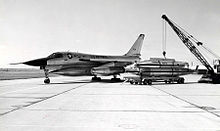I built this model several years ago. Back in the day when I didn't know anything about panel shading. Still looks good despite that.
From Wikipedia"
The Convair B-58 Hustler was the first operational jet bomber capable of Mach 2 flight. The aircraft was designed by Convair engineer Robert H. Widmer and developed for the United States Air Force for service in the Strategic Air Command (SAC) during the 1960s. It used a delta wing, which was also employed by Convair fighters such as the F-102, with four General Electric J79 engines in underwing pods. It carried five nuclear weapons; four on pylons under the wings, and one nuclear weapon and fuel in a combination bomb/fuel pod under the fuselage, rather than in an internal bomb bay.
Replacing the Boeing B-47 Stratojet medium bomber, it was originally intended to fly at high altitudes and supersonic speeds to avoid Soviet fighters. The B-58 was notorious for its sonic boom, which was often heard by the public as it passed overhead in supersonic flight.
The introduction of highly-accurate Soviet surface-to-air missiles forced the B-58 into a low-level-penetration role that severely limited its range and strategic value, and it was never employed to deliver conventional bombs. This resulted in only a brief operational career between 1960 and 1970 when the B-58 was succeeded by the smaller, swing-wing FB-111A.
The genesis of the B-58 program came in February 1949, when a Generalized Bomber Study (GEBO II) had been issued by the Air Research and Development Command (ARDC) at Wright-Patterson AFB, Ohio, for the development of a supersonic, long range, bombardment aviation platform. The proposed bomber's design and development was to begin less than two years after sustained supersonic flight had successfully been achieved. A number of contractors submitted bids to perform the generalized study (that hopefully would lead to a development contract) including Boeing, Convair, Curtiss, Douglas, Martin and North American Aviation.
Convair, building on its experience in earlier delta-wing fighters, beginning with the XF-92A, a series of GEBO II designs were developed, initially studying swept and semi-delta configurations, but settling on the delta wing planform. The delta planform had good internal volume for support systems and fuel. It also had low wing loading (for airframe size), thus permitting supersonic flight in the mid-stratosphere (50 – 70,000 feet). The final Convair proposal, coded FZP-110, was a radical two-place, delta wing bomber design powered by General Electric J53 engines. The performance estimates included a 1,000 mph (1,600 km/h; 870 kt) speed and a 3,000 statute mile (4,800 km; 2,600 nmi) range.
RB-58A with two component pod (TCP)
The resulting B-58 design was the first "true" USAF supersonic bomber program. The Convair design was based on a delta wing with a leading-edge sweep of 60° with four General Electric J79-GE-1 turbojet engines, capable of flying at Mach 2. Although its large wing made for relatively low wing loading, it proved to be surprisingly well suited for low-altitude, high-speed flight. It seated three (pilot, bombardier/navigator, and defensive systems operator) in separated tandem cockpits. Later versions gave each crew member a novel ejection capsule that made it possible to eject at an altitude of 70,000 ft (21,000 m) at speeds up to Mach 2 (1,320 mph/2,450 km/h). Unlike standard ejection seats of the period, a protective clamshell would enclose the seat and the control stick with an attached oxygen cylinder, allowing the pilot to continue to fly even "turtled up" and ready for immediate egress. The capsule was buoyant; the crewmember could open the clamshell, and use it as a life raft. In an unusual test program, live bears and chimpanzees were successfully used to test the ejection system. The XB-70 would use a similar system (though using capsules of a different design).










Very nice work...
ReplyDeleteThanks! Everyone likes this one for some reason.
ReplyDelete